The Featured Creatures collection provides in-depth profiles of insects, nematodes, arachnids and other organisms relevant to Florida. These profiles are intended for the use of interested laypersons with some knowledge of biology as well as academic audiences.
Introduction
The squash bug, Anasa tristis, attacks cucurbits (squash and relatives) throughout Central America, the United States, and southern Canada. Several related species in the same genus coexist with squash bug over most of its range, feeding on the same plants but causing much less injury.
Description and Life Cycle
The complete life cycle of squash bug commonly requires six to eight weeks. Squash bugs have one generation per year in northern climates and two to three generations per year in warmer regions. In intermediate latitudes, the early-emerging adults from the first generation produce a second generation whereas the late-emerging adults go into diapause. Both sexes overwinter as adults. The preferred overwintering site seems to be in cucurbit fields under crop debris, clods of soil, or stones but sometimes adults also are found in adjacent woodpiles or buildings.
Egg
Eggs are deposited on the lower surface of leaves, though occasionally they occur on the upper surface or on leaf petioles. The elliptical egg is somewhat flattened and bronze in color. The average egg length is about 1.5 mm (1/16 in) and the width about 1.1 mm (1/16 in). Females deposit about 20 eggs in each egg cluster. Eggs may be tightly clustered (Figure 1) or spread a considerable distance apart, but an equidistant spacing arrangement is commonly observed. Duration of the egg stage is about seven to nine days.
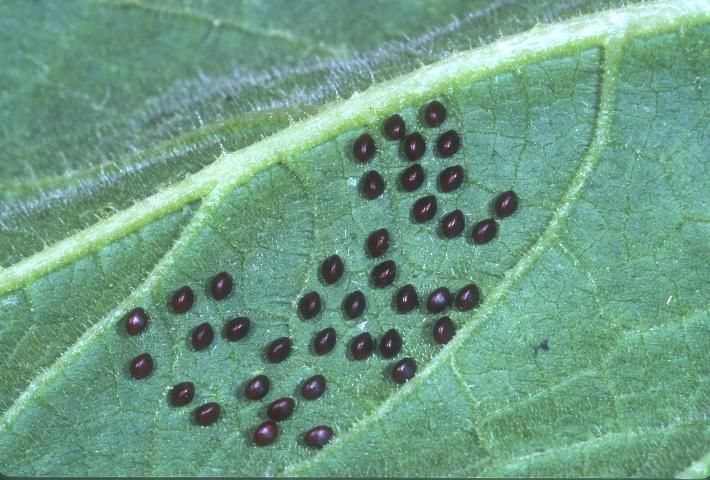
Credit: John L. Capinera, UF/IFAS
Nymph
There are five nymphal instars. The nymphal stage requires about 33 days for complete development. The nymph is about 2.5 mm (~1/8 in) in length when it hatches, and light green in color. The second instar is initially about 3 mm (~1/8 in) long, and its color is light gray. The third, fourth, and fifth instars initially are about 4 (~3/16 in), 6 to 7 (~1/4 in), and 9 to 10 mm (~3/8 in) in length, respectively, and darker gray (Figure 2). The youngest nymphs are rather hairy, but this decreases with each subsequent molt. In contrast, the thorax and wing pads are barely noticeable at hatch but get more pronounced with each molt. Young nymphs are strongly gregarious, a behavior that dissipates slightly as the nymphs mature.
Adult
The adult measures 1.4 to 1.6 cm (~1/2 in) in length and is dark grayish brown to black in color (Figure 2). In many cases, the edge of the abdomen is marked with alternating gold and brown spots. Adults are long-lived, surviving an average of about 75 to 130 days, depending on availability and quality of food.
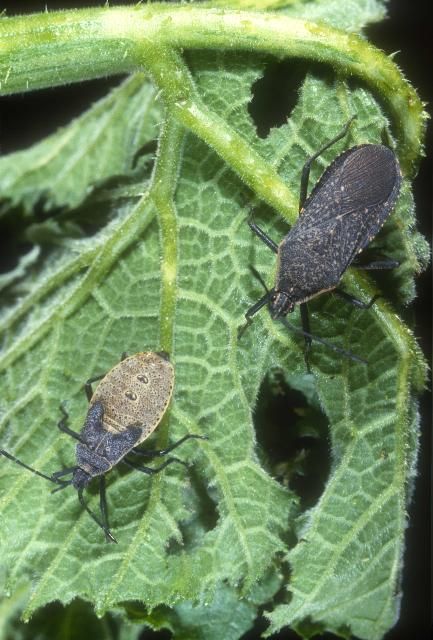
Credit: John L. Capinera, UF/IFAS
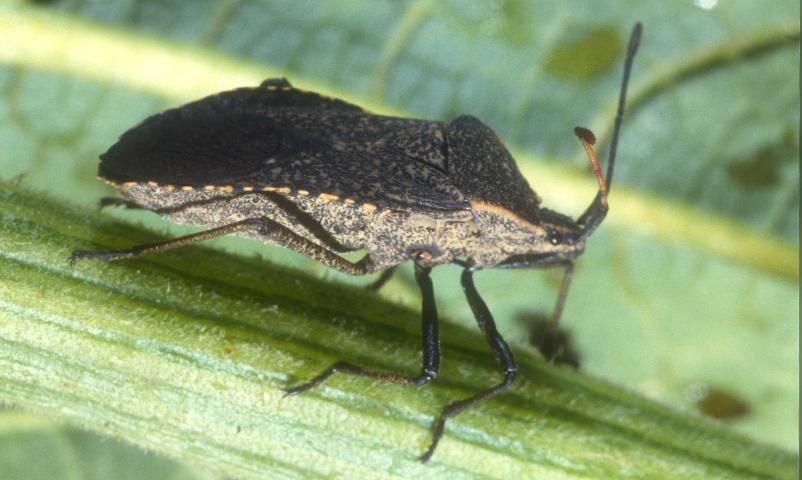
Credit: John L. Capinera, UF/IFAS
Host Plants
The squash bug has been reported to attack nearly all cucurbits, but squash and pumpkin are preferred for oviposition and support high rates of reproduction and survival. There is considerable variation among species and cultivars of squash with respect to susceptibility to damage and ability to support growth of squash bugs. New World varieties are preferred. Studies conducted in the United States reported survival of squash bug to be 70, 49, 14, 0.3, and 0% when nymphs were reared to the adult stage on pumpkin, squash, watermelon, cucumber, and muskmelon (cantaloupe), respectively. However, squash bugs are quite adaptable, and there is evidence that over time they can accept varieties that formerly were resistant to attack. In Oklahoma, for example, watermelon (generally considered to be a not very suitable host), is increasingly damaged by squash bug. Recent reports from Florida indicate the same.
Damage
The squash bug causes severe damage to cucurbits because it secretes highly toxic saliva into the plant. The foliage is the primary site of feeding but the fruit is also fed upon. The foliage wilts, becomes blackened, and dies following feeding; this malady is sometimes called "anasa wilt." Often an entire plant or section of plant perishes while nearby plants remain healthy. The amount of damage occurring on a plant is directly proportional to the density of squash bugs.
The squash bug can act as a vector of a bacterium (Serratia marcescens) that causes cucurbit yellow vine disease (CYVD), a relatively new problem occurring in cucurbits. This bug not only transmits the pathogen but harbors it within its body during the winter months when plants are not present.

Credit: John L. Capinera, UF/IFAS
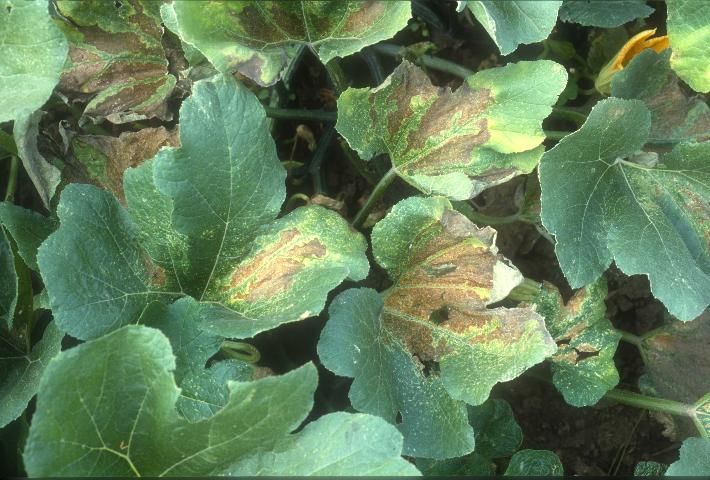
Credit: John L. Capinera, UF/IFAS
Natural Enemies
Several natural enemies of squash bug are known, principally wasp egg parasitoids (Hymenoptera: Encyrtidae and Scelionidae). Up to 30% parasitism among eggs collected in Florida, US has been reported. Cannibalism among nymphs is common, but this mortality factor has never been quantified. The bugs emit a strong odor when crushed, a fact that may account for low levels of predation. The best known natural enemy is a common parasitoid of several hemipterans, Trichopoda pennipes (Fabricius) (Diptera: Tachinidae). The brightly colored adult fly is easy to recognize, having a gold and black thorax and an orange abdomen, with a prominent fringe of feather-like hairs on the outer side of the hind tibia. Flies develop principally in the adult bug, initially castrating the female, and then killing her when the fly emerges. In Connecticut, US, about 20% of the squash bugs have been found to be parasitized in late summer.
Management
Squash bug adults are unusually difficult to kill with insecticides. Although adult control can be accomplished if the correct material is selected, it is advisable to target the more susceptible nymphs. Squash bugs are not often considered a severe pest of large-scale cucurbit production, probably due to the absence of suitable overwintering sites in well-managed crop fields and because the bug's effects are diluted by the vast acreage. Small fields and home gardens are commonly damaged. However, pollinators, particularly honeybees, are very important in cucurbit production, and insecticide application can interfere with pollination by killing honeybees, so care must be taken to avoid killing the pollinators. If insecticides are to be applied when blossoms are present, it is advisable to use insecticides with little residual activity, and to apply insecticides late in the day, when honeybee activity is minimal.
Adult squash bugs preferentially colonize larger, more mature plants. Thus, early-planted crops may be especially prone to attack. Numbers are also highest on plants during bloom and fruit set. Use of early-planted crops as a trap crop has been proposed, but due to the high value of early season fruit, most growers try to get their main crop to mature as early as possible. The use of squash or pumpkin as a trap crop to protect less preferred host plants such as melons and cucumbers is reported to be effective.
The tendency of squash bugs to aggregate in sheltered locations can be used to advantage by home gardeners. Placement of boards, large cabbage leaves, or other shelter for squash bugs induces the bugs to congregate there during the day where they are easily found and crushed. Row covers and netting delay colonization of squash, but bugs quickly invade protected plantings if covers are removed to allow pollination. Removal of crop debris in a timely manner is very important. Squash bugs will often be found feeding on old fruit or in abandoned plantings, so clean cultivation is essential to reduce the overwintering population. For registered chemical controls see: Insect Management Guide for Cucurbits (https://edis.ifas.ufl.edu/IN168).
Other Squash Bugs
Anasa tristis is not the only squash bug, though it is by far the most important. Other related species are shown in Figures 6–9. They are not commonly encountered and rarely are damaging.
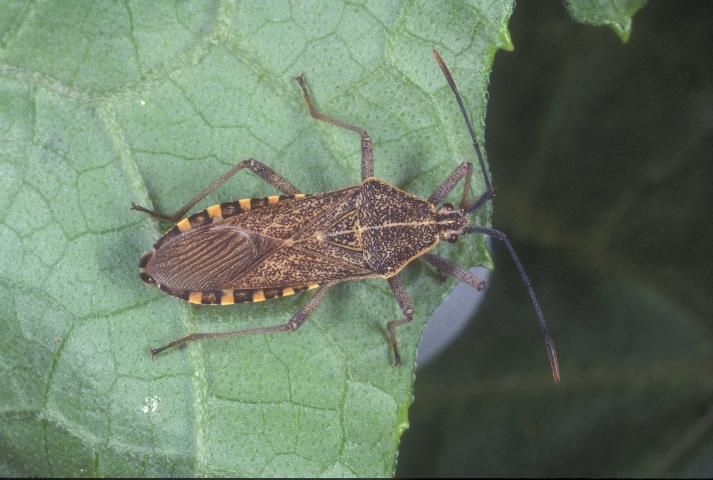
Credit: L. J. Buss, UF/IFAS
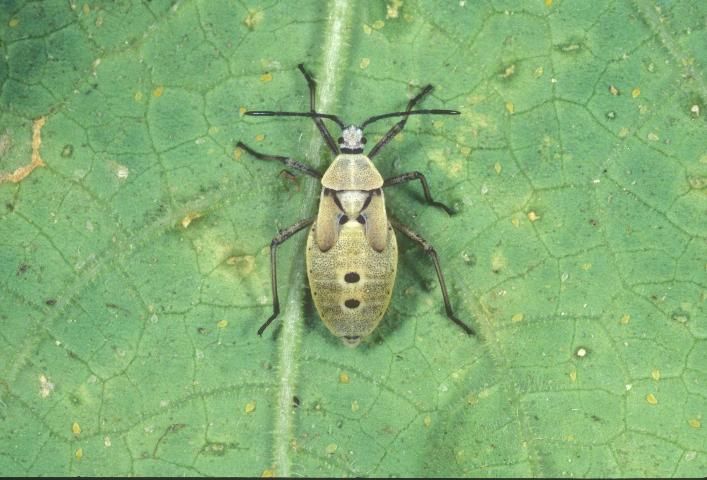
Credit: L. J. Buss, UF/IFAS

Credit: Jim Castner, UF/IFAS
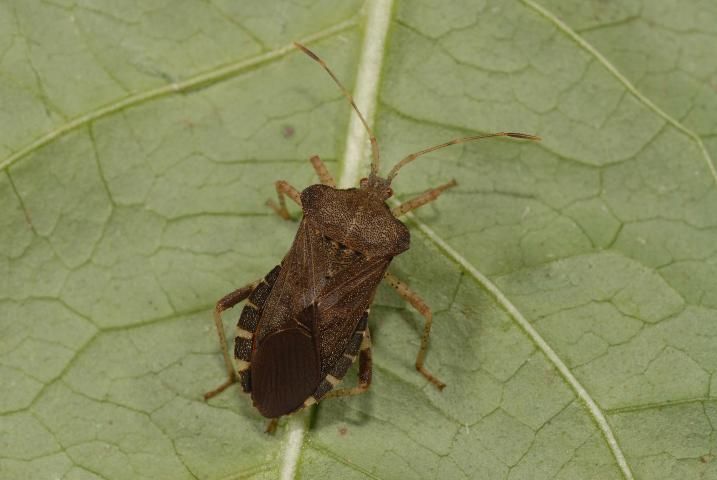
Credit: L. J. Buss, UF/IFAS
Selected References
Beard R.L. 1940. The biology of Anasa tristis DeGeer with particular reference to the tachinid parasite, Trichopoda pennipes Fabr. Connecticut Agricultural Experiment Station Bulletin 440:597–679.
Bonjour E.L. and W.S. Fargo. 1989. Host effects on the survival and development of Anasa tristis (Heteroptera: Coreidae). Environmental Entomology 18:1083–1085.
Bonjour E.L., W.S. Fargo, and P.E. Rensner. 1990. Ovipositional preference of squash bugs (Heteroptera: Coreidae) among cucurbits in Oklahoma. Journal of Economic Entomology 83:943–947.
Bonjour E.L., W.S. Fargo, A.A. Al-Obaidi, and M.E. Payton. 1993. Host effects on reproduction and adult longevity of squash bugs (Heteroptera: Coreidae). Environmental Entomology 22:1344–1348.
Bruton BD, Mitchell F, Fletcher J, Pair SD, Wayadande A, Melcher U, Brady J, Bextine B, Popham TW. 2003. Serratia marcescens, a phloem-colonizing, squash bug-transmitted bacterium: Causal agent of cucurbit yellow vine disease. Plant Disease 87:937–944.
Fielding DJ. 1988. Photoperiodic induction of diapause in the squash bug, Anasa tristis. Entomologia Experimentalis et Applicata 48:187–193.
Pair SD. 1997. Evaluation of systematically treated squash trap plants and attracticidal baits for early-season control of striped and spotted cucumber beetles (Coleoptera: Chrysomelidae) and squash bug (Hemiptera: Coreidae) in cucurbit crops. Journal of Economic Entomology 90:1307–1314.
Pair SD, Bruton BD, Mitchell F, Fletcher J, Wayadande A, Melcher U. 2004. Overwintering squash bugs harbor and transmit the causal agent of cucurbit yellow vine disease. Journal of Economic Entomology 97:74–78.